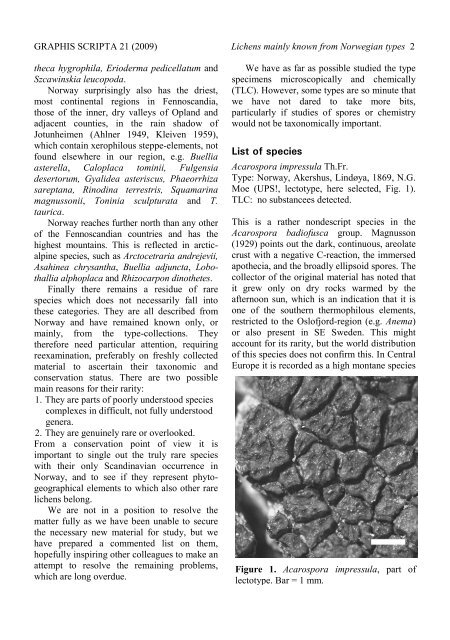(2009): Lichens in Scandinavia known mainly from Norwegian type ...
(2009): Lichens in Scandinavia known mainly from Norwegian type ...
(2009): Lichens in Scandinavia known mainly from Norwegian type ...
You also want an ePaper? Increase the reach of your titles
YUMPU automatically turns print PDFs into web optimized ePapers that Google loves.
GRAPHIS SCRIPTA 21 (<strong>2009</strong>) <strong>Lichens</strong> ma<strong>in</strong>ly <strong>known</strong> <strong>from</strong> <strong>Norwegian</strong> <strong>type</strong>s 2<br />
theca hygrophila, Erioderma pedicellatum and<br />
Szcaw<strong>in</strong>skia leucopoda.<br />
Norway surpris<strong>in</strong>gly also has the driest,<br />
most cont<strong>in</strong>ental regions <strong>in</strong> Fennoscandia,<br />
those of the <strong>in</strong>ner, dry valleys of Opland and<br />
adjacent counties, <strong>in</strong> the ra<strong>in</strong> shadow of<br />
Jotunheimen (Ahlner 1949, Kleiven 1959),<br />
which conta<strong>in</strong> xerophilous steppe-elements, not<br />
found elsewhere <strong>in</strong> our region, e.g. Buellia<br />
asterella, Caloplaca tom<strong>in</strong>ii, Fulgensia<br />
desertorum, Gyalidea asteriscus, Phaeorrhiza<br />
sareptana, R<strong>in</strong>od<strong>in</strong>a terrestris, Squamar<strong>in</strong>a<br />
magnussonii, Ton<strong>in</strong>ia sculpturata and T.<br />
taurica.<br />
Norway reaches further north than any other<br />
of the Fennoscandian countries and has the<br />
highest mounta<strong>in</strong>s. This is reflected <strong>in</strong> arcticalp<strong>in</strong>e<br />
species, such as Arctocetraria andrejevii,<br />
Asah<strong>in</strong>ea chrysantha, Buellia adjuncta, Lobothallia<br />
alphoplaca and Rhizocarpon d<strong>in</strong>othetes.<br />
F<strong>in</strong>ally there rema<strong>in</strong>s a residue of rare<br />
species which does not necessarily fall <strong>in</strong>to<br />
these categories. They are all described <strong>from</strong><br />
Norway and have rema<strong>in</strong>ed <strong>known</strong> only, or<br />
ma<strong>in</strong>ly, <strong>from</strong> the <strong>type</strong>-collections. They<br />
therefore need particular attention, requir<strong>in</strong>g<br />
reexam<strong>in</strong>ation, preferably on freshly collected<br />
material to ascerta<strong>in</strong> their taxonomic and<br />
conservation status. There are two possible<br />
ma<strong>in</strong> reasons for their rarity:<br />
1. They are parts of poorly understood species<br />
complexes <strong>in</strong> difficult, not fully understood<br />
genera.<br />
2. They are genu<strong>in</strong>ely rare or overlooked.<br />
From a conservation po<strong>in</strong>t of view it is<br />
important to s<strong>in</strong>gle out the truly rare species<br />
with their only Scand<strong>in</strong>avian occurrence <strong>in</strong><br />
Norway, and to see if they represent phytogeographical<br />
elements to which also other rare<br />
lichens belong.<br />
We are not <strong>in</strong> a position to resolve the<br />
matter fully as we have been unable to secure<br />
the necessary new material for study, but we<br />
have prepared a commented list on them,<br />
hopefully <strong>in</strong>spir<strong>in</strong>g other colleagues to make an<br />
attempt to resolve the rema<strong>in</strong><strong>in</strong>g problems,<br />
which are long overdue.<br />
We have as far as possible studied the <strong>type</strong><br />
specimens microscopically and chemically<br />
(TLC). However, some <strong>type</strong>s are so m<strong>in</strong>ute that<br />
we have not dared to take more bits,<br />
particularly if studies of spores or chemistry<br />
would not be taxonomically important.<br />
List of species<br />
Acarospora impressula Th.Fr.<br />
Type: Norway, Akershus, L<strong>in</strong>døya, 1869, N.G.<br />
Moe (UPS!, lecto<strong>type</strong>, here selected, Fig. 1).<br />
TLC: no substancees detected.<br />
This is a rather nondescript species <strong>in</strong> the<br />
Acarospora badiofusca group. Magnusson<br />
(1929) po<strong>in</strong>ts out the dark, cont<strong>in</strong>uous, areolate<br />
crust with a negative C-reaction, the immersed<br />
apothecia, and the broadly ellipsoid spores. The<br />
collector of the orig<strong>in</strong>al material has noted that<br />
it grew only on dry rocks warmed by the<br />
afternoon sun, which is an <strong>in</strong>dication that it is<br />
one of the southern thermophilous elements,<br />
restricted to the Oslofjord-region (e.g. Anema)<br />
or also present <strong>in</strong> SE Sweden. This might<br />
account for its rarity, but the world distribution<br />
of this species does not confirm this. In Central<br />
Europe it is recorded as a high montane species<br />
Figure 1. Acarospora impressula, part of<br />
lecto<strong>type</strong>. Bar = 1 mm.

















